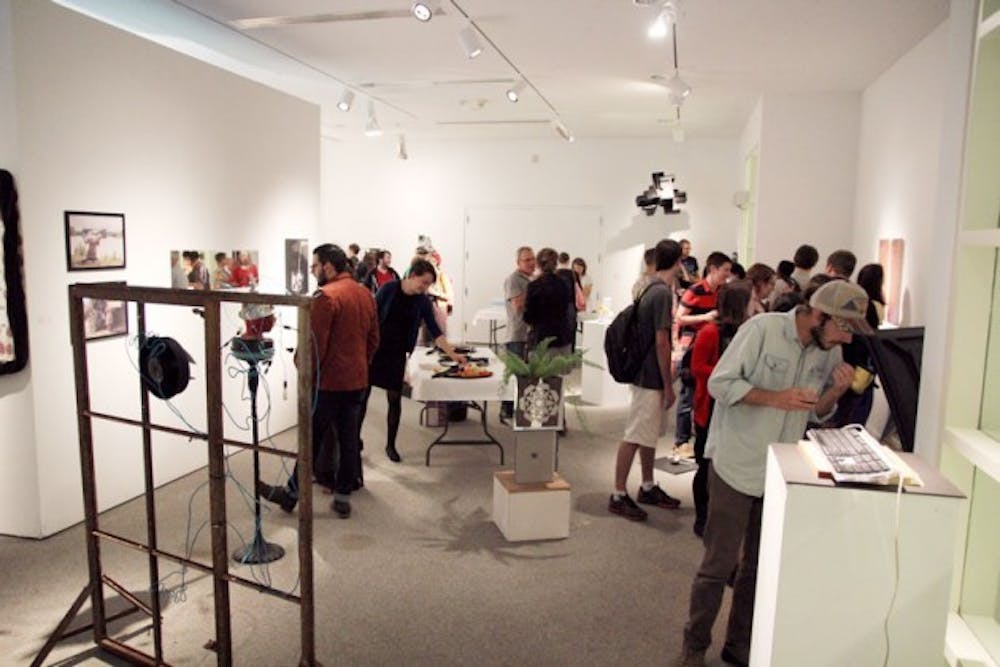A room full of digital projects, televisions, printers and a plastic Christmas tree might look like useless trash to someone walking by. But in a month, participants in the Cradle to Grave II: Re-Appropriation, Obsolescence and the Arts exhibits turned seemingly useless and outdated technologies into works of art.
Participants had from Aug. 25 to 29 to pick up one or two objects from the Lower Gallery in the Center for the Arts. Following, the 30 artists who picked up objects had a month to turn them into a multi-dimensional piece of artwork. The exhibit looked at the various ways technologies can be used after they’re replaced by new, more efficient options. It officially opened Sept. 25 and will remain open to the public until Oct. 18.
Untitled by Sangjun Yoo, a piece of art on display at Cradle to Grave II: Re-Appropriation, Obsolescence, and the Arts, used an overhead projector, filmstrips and Mylar, a type of plastic, to create a mesmerizing light installation.
“Conceptually, I wanted to use the film to trigger memories in each viewer,” said Yoo, a second year Masters of Fine Arts student. “I want people to translate film slides into their own lives. I got the film and the overhead from the department. They were just leftovers.”
Yoyo was able to capture the essence of the exhibition by using an overhead projector to create colorful lighting patterns, although it was not the object’s original intended purpose.
The university would have removed most of the items available for pick-up after a surplus or scrap form had been filled out, but this exhibit saved these items from that fate.
“We’re constantly trying to improve the technology at the CFA so we always have this excess and I’ve been collecting it,” said Natalie Fleming, the Visual Studies Resource Curator at UB. “We very easily assume items are obsolete and no longer have a purpose … we’re living in a world where we’re rapidly running out of resources. We can’t be so reckless.”
This is the second year in a row Fleming has taken charge of a Cradle to the Grave exhibition at UB. There were about 20 participants last year and more than 30 this year, including professor Reinhard Reitzenstein, photography instructor Daniel Calleri, MFA students like Yoo, undergrad students and a few local artists.
The exhibit was conceptualized with the intent to draw attention to what people do with their technological leftovers.
“We’re looking for ways to minimize the amount of waste we’re creating,” Fleming said. “Really, this exhibit should be called from Grave Back to Cradle. We’re re-purposing objects.”
The exhibition officially opened Sept. 25 at 5 p.m. in the Lower Gallery at the Center for the Arts. A variety of healthy snacks and wine were offered to the attendees and the crowded room was full of lively conversation.
There were many pieces of artwork on display that creatively re-purposed their supposedly dated technologies. One such piece was Technology (Or the Space Between Us), by Rosemary Williams, who graduated in the spring with a Bachelor’s in Fine Arts. Her piece is made up of four long rectangles and the attendees at the exhibition were encouraged to push on one side of the rectangle while someone else pushed on the other side.
“I chose to create a piece the viewer can interact with because of the nature of technology itself,” Williams said in email. “I wanted whoever was experiencing the piece to have fun, but also understand that technology not only brings us together … it also creates a strange barrier between the people using the technology.”
The rectangles in her piece are made out of dozens of used foam protectors that were sewn together.
“Art has a way of appreciating neglected objects, technologies and materials by nature of process,” Williams said. “The more time an artist spends with something, the more we think of cool ways to change it, make it better, make it funny, make it beautiful and have meaning.”
Most of the artwork on display proved that just because something may be considered dated, we might not want to dispose of it without entertaining other possible uses for the object.
“We very easily assume items are obsolete, used and no longer have a purpose,” Fleming said. “What is great about art and 21st Century artistic practice is we have a new way of looking at objects that have been discarded. We are reconsidering what we label now as garbage.”
The Cradle to the Grave II: Re-Appropriation, Obsolescence and the Arts exhibit will be open to the public until Oct. 18.
email: arts@ubspectrum.com





